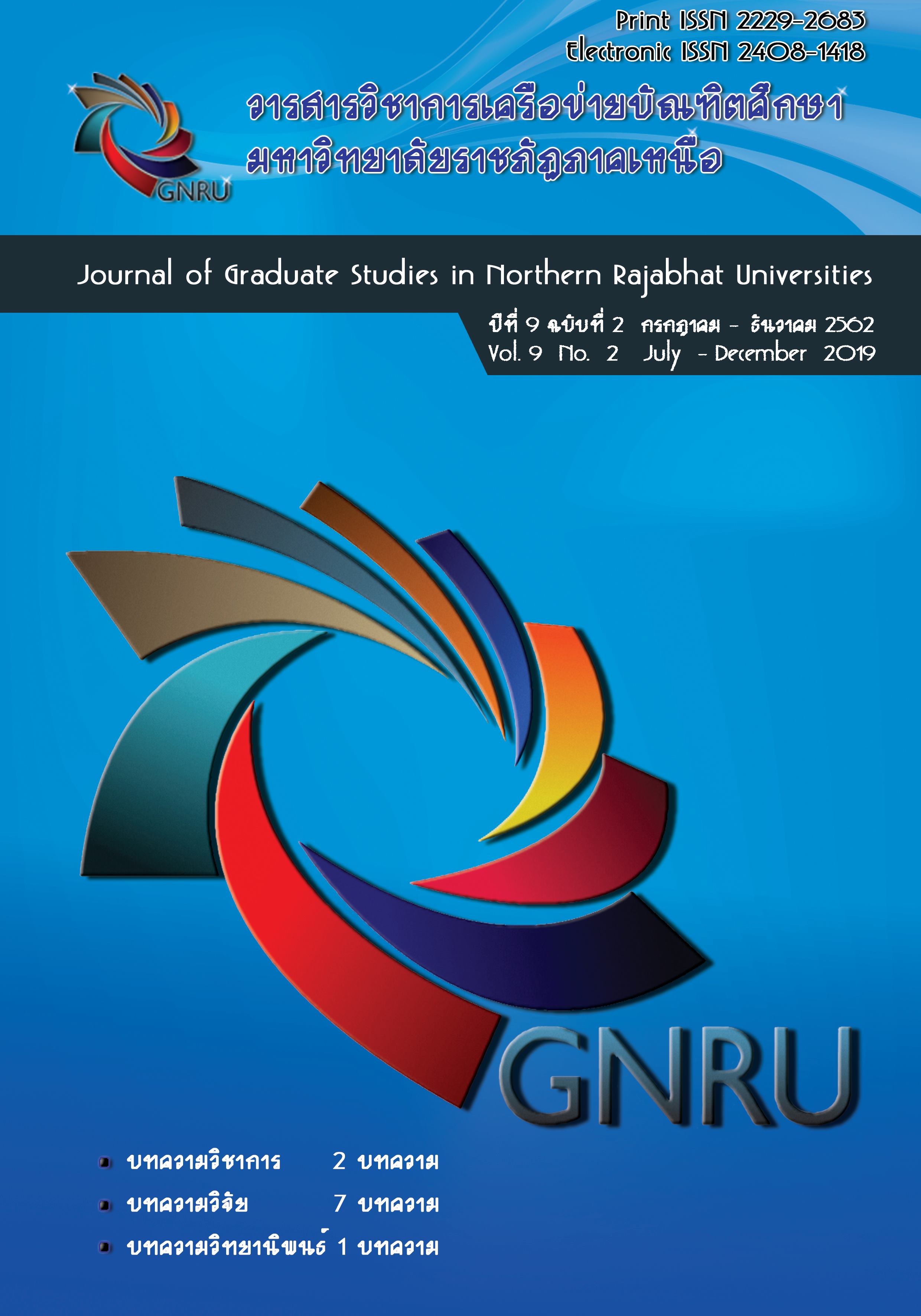ผลการใช้หลักสูตรพัฒนาทักษะการเขียนเชิงสร้างสรรค์โดยใช้กิจกรรมหนังสือเล่มเล็ก สร้างเสริมคุณลักษณะและค่านิยม ระดับประถมศึกษา The Use of a Syllabus in Developing Creative Writing Skill using Small Book Activities in Forming Good Habits and Values in Primary School
Main Article Content
Abstract
การวิจัยนี้มีวัตถุประสงค์เพื่อ พัฒนาหลักสูตรพัฒนาทักษะการเขียนเชิงสร้างสรรค์โดยใช้กิจกรรมหนังสือเล่มเล็กสร้างเสริมคุณลักษณะและค่านิยม เพื่อเปรียบเทียบผลสัมฤทธิ์ก่อนและหลังเรียน เพื่อศึกษาความคิดเห็นของผู้ใช้หลักสูตรและนักเรียนที่มีต่อหลักสูตร กลุ่มตัวอย่างได้มาโดยการสุ่มแบบง่าย ประกอบด้วย นักเรียนชั้นประถมศึกษาปีที่ 4 จำนวน 34 คน จาก 3 โรงเรียนฝึกประสบการณ์ของนักศึกษา สาขาวิชาการประถมศึกษา ประจำภาคเรียนที่ 2 ปีการศึกษา 2559 เครื่องมือที่ใช้ในการวิจัยและเก็บรวบรวมข้อมูล ได้แก่ หลักสูตรพัฒนาทักษะการเขียนเชิงสร้างสรรค์โดยใช้กิจกรรมหนังสือเล่มเล็กสร้างเสริมคุณลักษณะและค่านิยม ชั้นประถมศึกษาปีที่ 4 จำนวน 20 ชั่วโมง แบบทดสอบทักษะการเขียนเชิงสร้างสรรค์ แบบสัมภาษณ์ผู้ใช้หลักสูตร และแบบสัมภาษณ์นักเรียนที่เข้าร่วมกิจกรรมในหลักสูตร การวิเคราะห์ข้อมูลโดยหาค่าร้อยละ (%) ค่าเฉลี่ย ()ส่วนเบี่ยงเบนมาตรฐาน (S.D.) เปรียบเทียบค่าเฉลี่ยของคะแนนก่อนและหลังเรียนโดยวิเคราะห์ด้วยสถิติ t- test และวิเคราะห์ข้อมูลในรูปแบบพรรณนา ผลการวิจัยพบว่า
1. หลักสูตรพัฒนาทักษะการเขียนเชิงสร้างสรรค์ โดยใช้กิจกรรมหนังสือเล่มเล็กสร้างเสริมคุณลักษณะและค่านิยมมีค่าประสิทธิภาพเท่ากับ 84.87/80.50 สูงกว่าเกณฑ์ที่กำหนดไว้ 80/80
2. การเปรียบเทียบผลสัมฤทธิ์ทางการเรียนก่อนและหลังเรียน รวมทุกโรงเรียนและแยกรายโรงเรียน พบว่าแตกต่างกันอย่างมีนัยสำคัญทางสถิติที่ระดับ .05 โดยคะแนนทดสอบหลังเรียนสูงกว่าคะแนนทดสอบก่อนเรียน
3. ผู้ใช้หลักสูตรเห็นว่าหลักสูตรสามารถช่วยพัฒนาทักษะการเขียนของนักเรียน ส่งเสริมให้เกิดความคิดสร้างสรรค์ ทำให้นักเรียนเกิดความภาคภูมิใจในผลงานของตน หลักสูตรออกแบบได้ละเอียดเข้าใจง่าย สามารถนำไปจัดการเรียนการสอนจริง แต่ใช้ระยะเวลานานเกินไปกว่า 20 ชั่วโมง และควรเพิ่มกิจกรรมโดยให้นักเรียนใช้ทักษะหลากหลาย ทั้งนี้ครู นักเรียน และสภาพแวดล้อม เป็นปัจจัยสำคัญที่ทำให้หลักสูตรบรรลุเป้าหมาย
4. นักเรียนชอบการเขียนมากขึ้น มีความมั่นใจและภาคภูมิใจในการสร้างงานเขียนของตน เป็นกิจกรรมที่สนุก ได้ใช้ความคิดสร้างสรรค์ ทำให้นักเรียนอยากมีพฤติกรรมที่ดีตามเรื่องที่เขียน และอยากสร้างสรรค์ผลงานเขียนต่อไป
The purpose of this research were to construct a syllabus in developing creative writing skill using small book activities in forming good habit and values for students in primary school, to compare the achievement tests between pre and post of studies from the syllabus, to investigate the opinion of teachers and students dealing with syllabus implementation. The simple random samples were 34 fourth-grade students from 3 primary schools for teaching practice of Elementary Education program students of Chiang Mai Rajabhat University in the 2nd semester in 2016. Research instruments were the 20-hour learning activities syllabus, a creative writing test, an interview form for the teachers and the students. Data were analyzed to find percentage, mean scores, standard deviation, and t-test and content analysis. The findings were:
1. The syllabus had an efficiency value higher than the expected criteria 80/80, which had the value at 84.87/80.05.
2. The learning achievement tests comparing between pre and post of the study were different in all aspects and in different schools, with the statistic value of significantly difference at a level of .05.
3. The opinion of teachers stated that the syllabus was completely formed which was easy to be understood and really practical. The activities in the syllabus could help to improve students’ writing skill and enhance their creative thinking, and they were also proud of their writings. In contrast, they stated that the time of the activity was too long and the activity should be designed to practice various skills of the students. The significant factors in achieving the syllabus goal were teachers, students and learning setting.
4. The students stated that the activities could provoke them into writing, and helped them to be confident and proud of their writings. The activities were fun and helped their idea initiation. They thought that they needed to perform those good habits and values as cited in the writings, and they also wanted to do more writing.
Article Details
References
กระทรวงศึกษาธิการ. (2553). แนวทางการนำจุดเน้นการพัฒนาผู้เรียนสู่การปฏิบัติ. สืบค้นเมื่อ 18 ตุลาคม 2558, จาก https://www.secondary41.go.th/doc/joodnent2/Road%20Map%20gotowork.pdf.
กระทรวงศึกษาธิการ. (2546). พระราชบัญญัติการศึกษาแห่งชาติ พ.ศ.2542 และที่แก้ไขเพิ่มเติม (ฉบับที่ 2) พ.ศ.2545. กรุงเทพฯ: อักษรไทย.
กระทรวงศึกษาธิการ. (2553). หลักสูตรแกนกลางการศึกษาขั้นพื้นฐาน พุทธศักราช 2551. กรุงเทพฯ: ชุมนุมสหกรณ์การเกษตรแห่งประเทศไทย.
จิตรา จันทร์หอม. (2554). การศึกษาผลสัมฤทธิ์การเขียนก่อนการเรียนและหลังเรียนโดยใช้แบบฝึกเขียนเชิงสร้างสรรค์และแบบฝึกการเขียนที่ครูเป็นผู้กำหนดเนื้อเรื่องของนักเรียนชั้นประถมศึกษาปีที่ 4. ฉะเชิงเทรา: โรงเรียนเซนต์หลุยส์.
นพรัตน์ รองหมื่น. (2553). หนังสือเล่มเล็ก สื่อการสอนธรรมดาที่ไม่ธรรมดา การสร้างสรรค์และนำมา ประยุกต์ใช้ให้มีความหลากหลา. สืบค้นเมื่อ 12 กุมภาพันธ์ 2559, จากhttps://www.sahavicha.com/?name=article&file=readarticle&id=1677.
บรรจง อมรชีวิน. (2560). THINKING TEACHER อยากสอนศิษย์ให้คิดเป็น. กรุงเทพฯ: อมรินทร์บุ๊คเซ็นเตอร์.
มานัส ทิพย์สัมฤทธิ์กุล. (2553). กิจกรรมการเรียนรู้สู่โครงงานคณิตศาสตร์. กรุงเทพฯ: เบ็นพับลิชชิง.
รัตนะ บัวสนธ์. (2552). การวิจัยและพัฒนานวัตกรรมการศึกษา. กรุงเทพฯ: คำสมัย.
รุ่งนภา นาคะเต. (2558). หนังสือเล่มเล็ก. สืบค้นเมื่อ 23 กุมภาพันธ์ 2559, จากhttps://www.value.co.th/th/news/companynews/2558/amornwadi_minibook.htm.
สมพร ตอยยีบี. (2554). การพัฒนาแบบฝึกทักษะการเขียนเชิงสร้างสรรค์วิชาภาษาไทย สำหรับนักเรียนชั้นมัธยมศึกษาปีที่ 1 โรงเรียนเซนต์เทเรซา หนองจอก กรุงเทพฯ. ปริญญานิพนธ์การศึกษามหาบัณฑิต (การมัธยมศึกษา). บัณฑิตวิทยาลัย มหาวิทยาลัยศรีนครินทรวิโรฒ, กรุงเทพฯ.
สุนันท์ จันทร์วิเมลือง.(2551). การเขียนเชิงสร้างสรรค์. กรุงเทพฯ: วัฒนาพาณิชย์.
Andrew, M.S. (1996). Creating case study of two twenty grade students in a five art magnet school creative class. Dissertation Abstracts International. 56(10), 3860.
Clark, Dean., M.H, Rein.,T, & Joseph. (2017). Creative Writing Innovations: Breaking Boundaries in the Classroom. London: Bloomsbury Academic.
Tok.Ş.K, & Kandem.A. (2015). Effects of creative writing activities on students’ achievement in writing, writing dispositions and attitude to English. Procedia-Social and Behavioral Sciences, (174), 1635-1642.


